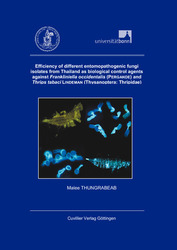| Fachbereiche | |
|---|---|
| Buchreihen (96) |
1379
|
| Nachhaltigkeit |
3
|
| Gesundheitswesen |
1
|
| Geisteswissenschaften |
2367
|
| Naturwissenschaften |
5407
|
| Mathematik | 229 |
| Informatik | 319 |
| Physik | 980 |
| Chemie | 1364 |
| Geowissenschaften | 131 |
| Humanmedizin | 243 |
| Zahn-, Mund- und Kieferheilkunde | 10 |
| Veterinärmedizin | 108 |
| Pharmazie | 147 |
| Biologie | 835 |
| Biochemie, Molekularbiologie, Gentechnologie | 121 |
| Biophysik | 25 |
| Ernährungs- und Haushaltswissenschaften | 45 |
| Land- und Agrarwissenschaften | 1004 |
| Forstwissenschaften | 201 |
| Gartenbauwissenschaft | 20 |
| Umweltforschung, Ökologie und Landespflege | 148 |
| Ingenieurwissenschaften |
1793
|
| Allgemein |
98
|
|
Leitlinien Unfallchirurgie
5. Auflage bestellen |
|
Erweiterte Suche
Efficiency of different entomopathogenic fungi isolates from Thailand as biological control agents against Frankliniella occidentalis (PERGANDE) and Thrips tabaci LINDEMAN (Thysanoptera: Thripidae)
Malee Thungrabeab (Autor)Vorschau
Inhaltsverzeichnis, Datei (19 KB)
Leseprobe, Datei (110 KB)
The present research aimed to study efficiency of 41 isolates of entomopathogenic fungi, belonging to 25 species from 11 genera isolated from different hosts in Thailand, as biological control agents against Frankliniella occidentalis (PERGANDE) and Thrips tabaci LINDEMAN (Thys., Thripidae). Firstly, the efficiency isolates was screened in the laboratory for the following characteristics: pathogenicity, virulence degree and effectiveness. In further experiments, the isolates that displayed highly efficient were subjected to studies biological and ecological characteristics, mode of infection, their efficiency under abiotic and biotic factors as well as side effects on non-target arthropods. Finally, persistence on different host plants and efficiency for controlling thrips under greenhouse conditions were investigated. In the laboratory, the results showed that 37 isolates for F. occidentalis and 36 isolates for T. tabaci were found to be pathogenic. The 16 isolates were highly pathogenic. Fungi isolates varied significantly in term of virulence. Five isolates were superior to all other isolates according to the virulence degree. The efficiency against all stages of both thrips species showed that the susceptibility decreased from larvae over pupae to adults. Beauveria bassiana Bb.5335 and Metarhizium anisopliae Ma.7965 displayed the highest efficacy throughout the following series of screenings and were used for further experimentation. Biological characteristics of B. bassiana and M. anisopliae were dependent on environmental factors but they did not greatly affect. The process involving pathogenicity on thrips began from 12 h and was completed within 72 h after inoculation. However, temperature and life stage of thrips were found to have effects on the development of pathogenicity process. The efficacy of the two fungi was higher at 25 and 30°C than at 18 and 35°C. Those increased with increasing relative humidity and varied according to the host plant whether on crop or ornamental plants. Both thrips species reared on cucumber were highly susceptible to fungal infection but significantly less susceptible when reared on saintpaulia. B. bassiana and M. anisopliae had low side effects on non-target beneficial arthropods.
| ISBN-13 (Printausgabe) | 3865379613 |
| ISBN-13 (Printausgabe) | 9783865379610 |
| ISBN-13 (E-Book) | 9783736919617 |
| Buchendformat | A5 |
| Sprache | Englisch |
| Seitenanzahl | 128 |
| Auflage | 1 |
| Band | 0 |
| Erscheinungsort | Göttingen |
| Promotionsort | Bonn |
| Erscheinungsdatum | 30.07.2006 |
| Allgemeine Einordnung | Dissertation |
| Fachbereiche |
Land- und Agrarwissenschaften
|








